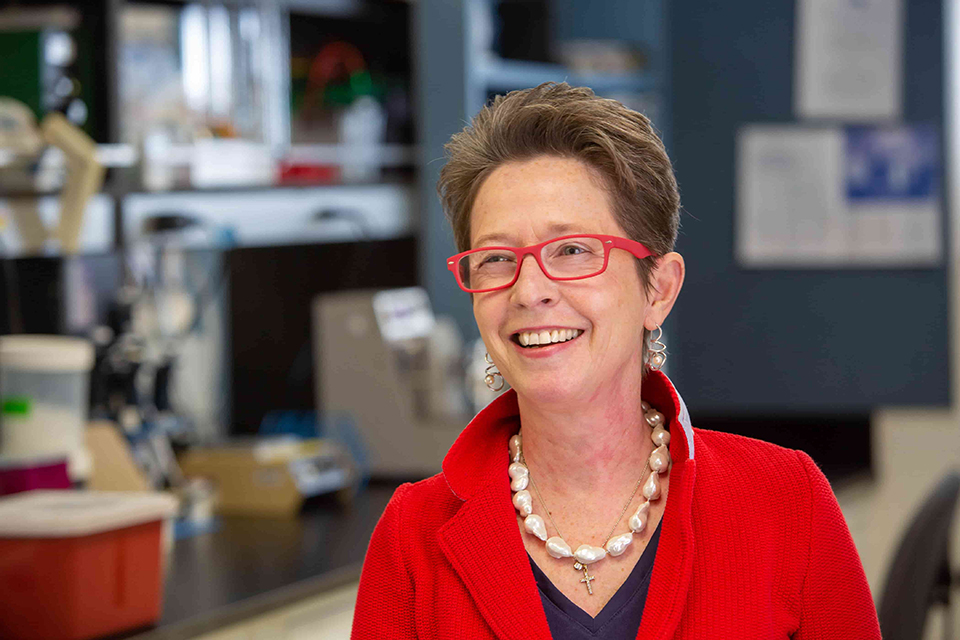Neuropathic pain affects millions of Americans every year. This fact combined with the nationwide crisis of opioid misuse reinforces the need for safer and more effective therapies to help those suffering from chronic pain. In tandem with efforts from the National Center for Advancing Translational Sciences and in an effort to advance research in this arena, in 2017 the ICTS offered a new funding program focused on strategies to address the opioid epidemic.
Daniela Salvemini, PhD, William Beaumont Professor and Chair, Department of Pharmacology and Physiology and Director of The Henry and Amelia Nasrallah Center for Neuroscience at Saint Louis University, has studied the mechanisms of pain in a career that that has bridged the private and public sectors. For the past 15 years at Saint Louis University, Salvemini has led a translational lab, using multidisciplinary approaches to unravel molecular and biochemical signatures of chronic pain to discover new targets for therapeutic intervention. In 2017, Salvemini was researching how neuropathic pain occurs at the cellular and molecular level and how it can be turned off in a laboratory setting. Familiar with ICTS funding programs as a previous reviewer for the Clinical and Translational Research Funding Program, she thought this new opioid funding mechanism could help her take the next step with her research. Salvemini submitted her proposal and in March 2018 received a one-year award through the ICTS Opioid Epidemic Research Funding Program for the project titled, “Novel Non-Narcotic Based Therapeutics for Chronic Pain”.
With funds matched by Saint Louis University, Salvemini and her team were able to get additional data needed to demonstrate that a particular cellular receptor is responsible for the development of traumatic nerve injury pain in an animal model. By using a multidisciplinary approach, they provided evidence that sphingosine-1-phosphate (S1P) generated in the dorsal horn of the spinal cord in response to nerve injury drives neuropathic pain by selectively activating the S1P receptor subtype 1 (S1PR1) in astrocytes. The findings concluded that the activation of S1PR1 is what activates and sustains neuropathic pain and turning it off is necessary to stop the development of neuropathic pain. “Pain pathways appeared to depend on the activation of S1PR1 – and conversely blocking this signal limits or stops pain”, describes Salvemini. “These findings suggested the need to target this receptor with compounds that offer pain-killing benefits without the risks of opioids.” From this research, Salvemini and her team published “Sphingosine-1-phosphate receptor 1 activation in astrocytes contributes to neuropathic pain” in the May 21, 2019 issue of Proceedings of the National Academy of Sciences (PNAS).
The publication of this paper was a turning point for Salvemini’s research. “Having discovered that the S1PR1 was involved in neuropathic pain gave us the opportunity to make a strong case for repurposing drugs that are used in other indications,” reflects Salvemini. “It provided a good opportunity to probe this receptor in humans with drugs that are already in use. And the key point is that they are not opioids.”
Since the publication in PNAS, Salvemini’s work has been recognized on a national level. In October 2020, she received the 2020 Pharmacia-AsPET award for experimental therapeutics for her contributions to the understanding of molecular and cellular neuropathic pain. And in 2019, Salvemini was named a Fellow of the National Academy of Inventors (NAI) for her effort to find better treatments for pain.
Today, Salvemini continues her research and remains active with the ICTS. “The ICTS provides a variety of resources to assist investigators. It certainly made the difference with our work on the S1PR1 receptor”, recalls Salvemini. “I advocate for my faculty to take advantage of what the ICTS has to offer. It can be really valuable in taking your research to the next level.”
Read more about Daniela Salvemini, PhD and her research on the mechanisms of pain.
